| |
|
Remarkable objects at Rockelstad
The Great Bear
|
In the lower floor of the Great Hall are many of remaining objects from the
von Rosen family. The Great Russian bear was killed with a spear, by
Eric von Rosen in Karelia. Eric was invited by the Finnish authorities to
hunt bear during his expedition to Laplandia in 1904, for the area suffered
from a bear invasion. Von Rosen killed 22 bears, and the two largest he chose
to meet the Viking way, with only a spear. Those two bears were preserved and
placed at Rockelstad. He accidentally killed a female bear with cubs, which he
brought with him back to Sweden. One he named Mischka and took as a pet, it
ran around freely in the Park and terrified the visitors. It slept in the
foot-end of Eric's bed until his marriage with Mary, who was not too happy
about sharing beds with a fully grown bear.
|
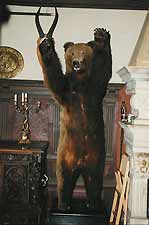
The Great Bear
|
The Samurai
This Japanese suit of armour was manufactured during the Ashikaga-shogunate
at the end of the sixteenth century. It is made up of sheets of wrought steel
that have been lacquered black and decorated with red and gold, and then tied
together with silk strings. It is equipped with a face-mask, which indicated
that it belonged to a samurai in the Imperial Guard, for it was not permitted
to show your face to the Divine Emperor. On several places are painted its
original owner's coat of arms, so it is possible to trace who actually wore it.
On top of the helmet is fastened a magnificent bush of human hair. This armour
was brought to Sweden with the ship Vega in 1878 after the first successful
attempt to reach Asia via the North-East Passage, that is north of Siberia and
through Berings Sound. The explorer Adolph Erik Nordenskjold was received with
great pomp in Japan, and was the first European to be invited to meet the
Emperor since the opening of trade in 1866. This samurai armour was one of five
given to Nordenskjold by the Emperor, and it was given to Eric von Rosen on his
fifty-year birthday in 1929 by Erland Nordenskjold.
|
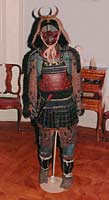
The Samurai
|
The Great Bridal Chest
|
Placed in
between the Bear and the Samurai is an enormous bridal chest of oak. Its front
has arches and four reliefs depicting episodes from the Bible. These carvings
are flanked by herms with primitive portrait busts and the coats of arms of the
two families. This renaissance chest was made in the late sixteenth century,
probably in the south of Sweden of Denmark. It was part of the von Rosen
collection of renaissance furniture. Such chests were designed to contain the
bride's dowry, and only the upper nobility could afford to fill this
substantial chest with expensive items.
|
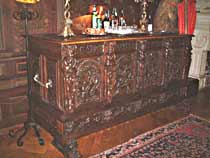
The Great bridal chest
|
The Dining room cupboards
In the old
dining room are two cupboards, both of oak wood. One of them has a slightly
lighter hue; it has simple geometrical
patterns on its doors, a richly carved top end and three male heads with
funny-looking hats. It has three wrought-iron-like ornaments of ebony, which
together with a vertical linear pattern appears almost gothic. This cupboard is
probably North-German, made in mid 16th century, and it is preserved
in its original form. The darker of the cupboards has quadruple doors carved
with arches and biblical scenes, and three pillars with ionic capitals. It is a
bit later; it dates from around 1600, and it has been partly repaired about 100
years ago.
|
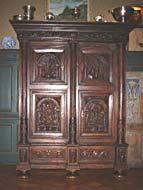
Dining room cupboards
|
The Napoleon Bed
The Napoleon Tower is a room in the north-western part of the castle, used as the
wedding-suite. The name comes from the fantastic bed, made in Paris in 1812 in the
style of Napoleon himself; the Empire-style. Its heavily curved head- and foot
ends are adorned with gilded eagle-heads, and the bed stands on robust claw-and-ball
feet. This style is a result of Napoleons wars in Italy 1796 and in Egypt 1798.
The art and buildings from the antiquity abundant in these countries became a source
of inspiration for designers and architects throughout the West. The bed has
previously been at a neighbouring estate, whose owner's ancestor originally took it
from France.
|
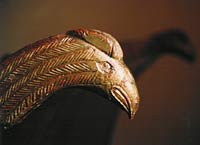
The Napoleon Bed
|
The Gothic Chest
|
This remarkable chest is the only remaining piece of Count Eric von Rosen’s great
collection of gothic furniture. It is made of oak and has a high, richly carved
back, decorated with primitive grape-vines and other favourite gothic
ornaments. Beneath these are sections carved with a late-gothic version of the
typical linenfold-pattern, a vertical profiling that aims to give an impression
of a piece of folded linen-cloth. This chest has sometime during the 15th
century been part of the interior of a monastery or church, and is believed to
be of Scottish origin.
|
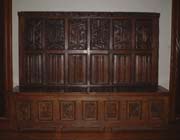
The Gothic Chest
|
The Mastodon Tusk
In the window-niche toward the yard is a giant tusk of a mastodon. The mastodon
is a relative of the mammoth, one of the largest species of elephant ever to have
walked the surface of the earth. The tusk, however is, not of ivory, but is
completely fossilized, and consists of limestone. It was discovered among many
other prehistoric remains, in a crest in the Cochabamba-valley in southern Bolivia.
This was in 1901, during Eric von Rosen's South American expedition. It was at
that time the largest tusk ever to have been found. A collection of smaller tusks
were donated by the Count to the Museum of Natural Science in Stockholm
|
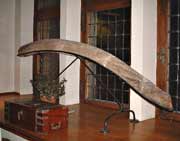
The Mastodon Tusk
|
The Sarcophagus of St. Henry
In the chapel in the south-eastern tower is a set of copperplate prints with gothic
motifs. They are in fact taken off a sarcophagus in the Cathedral of Abo, which
holds the remains of St Henry, the saint of Finland. It is a made of black diabase,
clad with engraved sheets of brass, manufactured in the Flanders sometime around
1420, and it illustrates the history of the christening of Finland.
In the early thirteen hundreds
the Pope assigned to the English bishop Henry, in an alliance with the Swedish King
Erik (the Holy), exterminate paganism in Finland. This crusade went well,
they baptized the ones they didn't kill, and Finland
became a part of Sweden.
But the Bishop Henry had the misfortune to annoy the peasant Lalli, for the
noble procession had eaten all his stored food without paying. Lalli then uses
his axe and quickly kills the Bishop and escapes, after having chopped off one
of the Bishop's fingers to get the Bishop's ring. He places the finger in his
pocket and then runs across the Finnish ices, where he accidentally drops the
Bishop's finger. The killer manages to stay hidden well into the summer, when a
young fisherman and his blind old father come upon a sheet of ice that has
refused to melt in spite of the warmth. Upon the ice sits the Holy Spirit, in
the form of a falcon, guarding the Bishop's finger. The young fisherman gives
the finger to his blind father, who then miraculously regains his ability to
see, and with this new and divine sight, he can spot the killer's hideout.
These prints were a gift to Eric von Rosen from the government of Finland,
thanking for von Rosen's aid to the Finnish national movement during the war
of liberation from Russia in 1918. The Finnish general Mannerheim had asked
the Nordic neighbouring countries for aid, especially in the form of aeroplanes,
but without response. Eric von Rosen could not abide the cowardice of the Swedish
government, so he decided to buy an aeroplane himself, which he and the pilot
Nils Kindberg flew from Sweden to Abo. This was actually the first crossing of
the Baltic Sea with an aeroplane, but more importantly it became the start of a
massive campaign of support for the Finnish Cause, that eventually made it
possible for Finland to become an independent state.
|
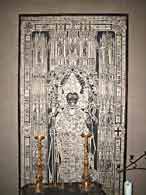
Top of the Sarcophagus of St. Henry
|
|
| |
|





















